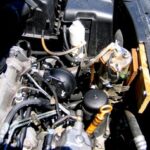Dating back to the 19th century, turbocharger technology has a long history of being used to increase the power output of internal combustion engines. In fact, turbo systems are so widely-known that they have become a metaphor for maximized performance, such as when the term “turbocharged” is used to describe high-speed computer and software upgrades.
However, optimizing horsepower is only half the story when it comes to modern-day turbo technology. With the increasing demand for fuel-efficient, environmentally-friendly vehicles, many manufacturers are turning to turbocharged engines to obtain maximum gas mileage with the lowest possible carbon emissions.
The Four-Stroke Process
To understand the function of turbochargers, first you have to know the basics of the internal combustion process. Basically, car engines generate the power used for acceleration by detonating small amounts of air and fuel thousands of times per minute. This combustion occurs through a four-stroke process.
During the first stroke, or intake cycle, pistons inside of the engine move downward, which draws air into the cylinders. The pistons are then driven back upward, compressing the air that was drawn in. When the piston reaches its top-most position, fuel is injected into the air mixture, which is then ignited by a spark plug. This is the third stroke, or combustion cycle, which generates the energy used for acceleration by forcing the pistons back downward. During the final stroke, the exhaust cycle, the pistons again move upward, forcing the combustion remnants out of the cylinder and into the exhaust system.
How Turbo Systems Work into the Equation
Since engines generate horsepower by combusting an air-fuel mixture, it follows that increased amounts of air and fuel will produce an increased output of power. This is where the turbo system comes in.
The turbo charger itself consists of two turbines linked by a propellor shaft. The snail-shaped turbo housing allows air to be routed past the turbines. The exhaust turbine is thus routed into the exhaust system, such that the spent gasses leaving the engine cause the turbine to spin, or spool. This in turn causes the intake turbine to spin, which draws in and compresses air.
Since the intake turbine is routed into the intake system of the engine, the turbocharger effectively forces compressed air into the cylinder, drastically increasing the amount of air and fuel that can be combusted during each cycle. As mentioned above, more air and fuel equals more horsepower.
Utilizing Low Displacement for Maximum Fuel Efficiency
It may seem paradoxical that turbo systems are used both to maximize horsepower and acceleration while also improving fuel efficiency and emissions. The way this is accomplished is through utilizing lower-displacement engines.
The displacement of an engine is a measure of the combined volume of all the cylinders. In naturally-aspirated engines, power is most dramatically increased through an increase in displacement, such as when utilizing a V8 engine instead of a V6. The problem is that, as displacement increases, fuel efficiency and emissions generally suffer.
However, turbo systems allow manufacturers to drastically increase power output without using a larger-displacement engine. When heavy acceleration is needed, the turbo system spools and increases the air available for combustion, thus offering the performance of a larger-displacement engine. However, under light loads such as highway cruising, the engine exhaust output is low enough that the turbo compressor wheel doesn’t spool. This way, the driver gets the fuel efficiency and low emissions of an economy engine while having adequate acceleration on tap whenever it is needed.




